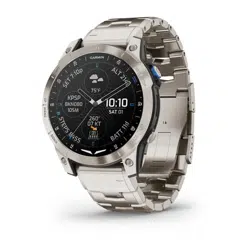Loading ...
Loading ...
Loading ...

Syncing Manually with the Aviation Database
When your watch is connected to a Wi‑Fi wireless network, database updates are downloaded automatically
overnight. You can also manually sync with the database at any time.
1 Hold MENU.
2 Select Connectivity > Wi-Fi > Aviation Database Updates.
3 Wait while your data syncs.
User Profile
You can update your user profile on your watch or on the Garmin Connect app.
Setting Up Your User Profile
You can update your gender, date of birth, height, weight, wrist, heart rate zone, power zone, and Critical Swim
Speed (CSS) settings (Recording a Critical Swim Speed Test, page 40). The watch uses this information to
calculate accurate training data.
1 Hold MENU.
2 Select User Profile.
3 Select an option.
Viewing Your Fitness Age
Your fitness age gives you an idea of how your fitness compares with a person of the same gender. Your watch
uses information, such as your age, body mass index (BMI), resting heart rate data, and vigorous activity history
to provide a fitness age. If you have a Garmin Index scale, your watch uses the body fat percentage metric
instead of BMI to determine your fitness age. Exercise and lifestyle changes can impact your fitness age.
NOTE: For the most accurate fitness age, complete the user profile setup (Setting Up Your User Profile, page 95).
1 Hold MENU.
2 Select User Profile > Fitness Age.
About Heart Rate Zones
Many athletes use heart rate zones to measure and increase their cardiovascular strength and improve their
level of fitness. A heart rate zone is a set range of heartbeats per minute. The five commonly accepted heart
rate zones are numbered from 1 to 5 according to increasing intensity. Generally, heart rate zones are
calculated based on percentages of your maximum heart rate.
Fitness Goals
Knowing your heart rate zones can help you measure and improve your fitness by understanding and applying
these principles.
• Your heart rate is a good measure of exercise intensity.
• Training in certain heart rate zones can help you improve cardiovascular capacity and strength.
If you know your maximum heart rate, you can use the table (Heart Rate Zone Calculations, page 97) to
determine the best heart rate zone for your fitness objectives.
If you do not know your maximum heart rate, use one of the calculators available on the Internet. Some gyms
and health centers can provide a test that measures maximum heart rate. The default maximum heart rate is
220 minus your age.
User Profile 95
Loading ...
Loading ...
Loading ...
